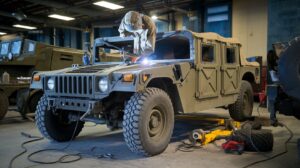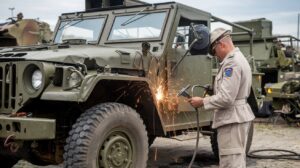The Importance of Repairing Military Vehicles
Military vehicles, from tanks and armored personnel carriers to trucks and helicopters, are subjected to intense wear and tear in combat environments. These vehicles face a variety of challenges such as rough terrain, extreme weather, enemy fire, and mechanical failure due to heavy usage. A single malfunction or failure can significantly impair the operational capability of a unit, potentially jeopardizing missions and lives.
Rapid vehicle repair is critical for several reasons:
- Combat Readiness: Military forces need to be ready for rapi

Repairing Military Vehicles: A Critical Role in Maintaining Combat Readiness d deployment and action. A vehicle that is out of commission due to a malfunction can delay or even halt the movement of troops, ammunition, and supplies. This could have dire consequences in the fast-paced and unpredictable environment of battle.
- Minimizing Downtime: The longer a military vehicle is out of service, the greater the impact on operational effectiveness. Repairing vehicles quickly ensures that they return to action with minimal downtime, preserving the integrity of the mission and the safety of personnel.
- Cost-Effectiveness: Repairing damaged military vehicles is often far more cost-effective than replacing them. Many military vehicles are built to be durable and are designed for long-term service. With proper maintenance and repairs, a vehicle can continue to serve for many years.
- Logistical Efficiency: Military operations involve complex supply chains, and having operational vehicles ensures the efficiency of these supply chains. Vehicles are used for transporting troops, equipment, and supplies, so keeping them in top working condition is essential to maintain logistics.
Types of Military Vehicles Requiring Repair
Military vehicles come in a variety of types, each designed for specific roles in combat or logistics. The common types of military vehicles that require repair include:
- Tanks: Armored fighting vehicles, such as tanks, are heavily armored and heavily armed machines used for ground combat. They are subjected to intense fire and harsh environmental conditions. Maintenance and repair of tanks often involve replacing damaged tracks, fixing mechanical issues in the engine, and repairing armor that has been penetrated.
- Armored Personnel Carriers (APCs): APCs are used to transport troops safely into battle while providing some protection from enemy fire. Repairing APCs may include fixing damaged armor, replacing broken suspension components, or addressing electrical and communication system failures.
- Military Trucks: These vehicles are essential for transporting equipment, fuel, and supplies to military units. Repairs typically focus on the engine, drivetrain, tires, and cargo areas. Military trucks also need to be equipped for off-road travel, so repairs may address suspension and braking systems.
- HMMWV (Humvee): The High Mobility Multipurpose Wheeled Vehicle, or Humvee, is one of the most iconic military vehicles used for reconnaissance, troop transport, and logistical support. Given its high mobility, it is frequently involved in situations where it may sustain damage. Repairs can involve replacing tires, fixing suspension systems, and addressing structural damage from small arms fire or explosions.
- Helicopters and Aircraft: While not traditional “ground” vehicles, military aircraft like helicopters and fighter jets also require frequent repairs in operational environments. Repairing military helicopters involves maintaining rotor systems, engines, avionics, and fuselage integrity, often under time-sensitive conditions.
The Process of Repairing Military Vehicles
Repairing military vehicles involves several stages, each requiring specialized knowledge, tools, and skills. The process can be broken down into the following key steps:
- Assessment and Diagnosis: The first step in repairing any military vehicle is diagnosing the problem. A thorough assessment of the vehicle’s mechanical and structural components is conducted to identify the root cause of the issue. This could involve visual inspection, diagnostic tools, and sometimes even test drives or test flights. Technicians must also consider the environmental factors the vehicle has been subjected to, as these can influence the type of damage.
- Disassembly and Inspection: Once the problem has been identified, the next step is to carefully disassemble the relevant parts of the vehicle for closer inspection. For example, a tank may require the removal of armor panels to assess damage to the internal systems. In the case of a military truck, mechanics may remove the wheels, suspension components, or engine parts to determine the source of the issue.
- Repair or Replacement of Components: After identifying damaged components, the technician will either repair or replace them. For example, if a vehicle’s suspension system is damaged, components such as shock absorbers, springs, or axles may need to be replaced. For heavily armored vehicles like tanks, repair may involve welding or patching armor, especially after battle damage. If a part is beyond repair, it is often replaced with a new or refurbished part.
- Reassembly and Testing: After the necessary repairs are completed, the vehicle is reassembled and tested. Testing is crucial to ensure that the vehicle is fully functional and that no issues remain. In some cases, this involves test driving the vehicle on rough terrain or conducting performance checks to ensure all systems are operational.
- Maintenance and Preemptive Repairs: In addition to repairing damage, regular maintenance and preemptive repairs are essential for keeping military vehicles in optimal condition. Regular inspections help to identify potential issues before they become major problems, ensuring the vehicle remains operational for the long term. Common maintenance tasks include oil changes, tire rotations, cleaning and replacing filters, and checking fluid levels.

Repairing Military Vehicles: A Critical Role in Maintaining Combat Readiness
Tools and Technologies Used in Military Vehicle Repair
To repair military vehicles efficiently, technicians use a range of tools and advanced technologies. Some of the most important tools and technologies include:
- Diagnostic Equipment: Modern military vehicles are equipped with sophisticated electronics and sensors. To diagnose issues, technicians often use advanced diagnostic equipment that interfaces with the vehicle’s computer systems to pinpoint malfunctions.
- Welding Equipment: For repairing damage to armored vehicles like tanks or APCs, welding equipment is essential. Whether it’s fixing structural damage to the chassis or reinforcing armor, specialized welding tools are used for high-strength repairs.
- Field Repair Kits: Military personnel are often required to perform repairs in the field. To facilitate this, field repair kits are available, containing essential tools such as wrenches, screwdrivers, pliers, and specialized parts.
- Mobile Repair Units: Some military units are equipped with mobile repair vehicles that can be deployed in the field. These units carry all the necessary tools and parts to repair a wide variety of vehicles, ensuring that the unit can continue its operations with minimal delays.
- 3D Printing: In some cases, 3D printing technology is used to manufacture parts on-site, which can be particularly useful in remote locations. This technology allows for the rapid production of small, critical parts that may not be readily available.
Conclusion
The repair of military vehicles is a complex and vital task that requires specialized knowledge, tools, and training. The ability to quickly repair vehicles ensures that military units remain operational, minimizing downtime and preserving combat readiness. Whether it’s replacing a damaged suspension, welding a tank’s armor, or conducting routine maintenance on a military truck, the work done by military mechanics and technicians is indispensable to the success of military operations.
As technology advances, so too does the capability to repair and maintain military vehicles. With new tools, diagnostic equipment, and repair methods constantly being developed, military personnel are better equipped than ever to keep their vehicles in top shape, ready for action whenever needed.